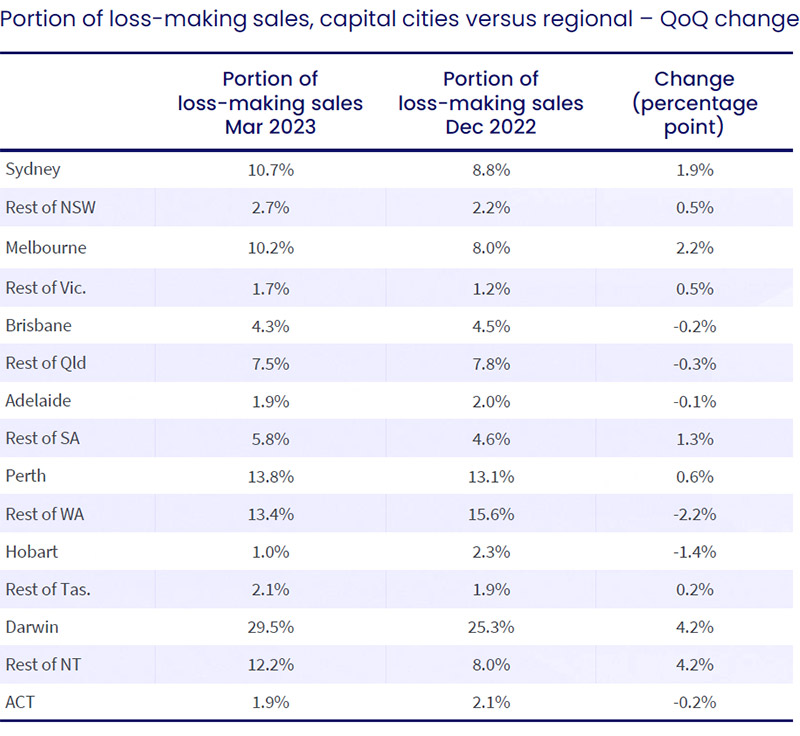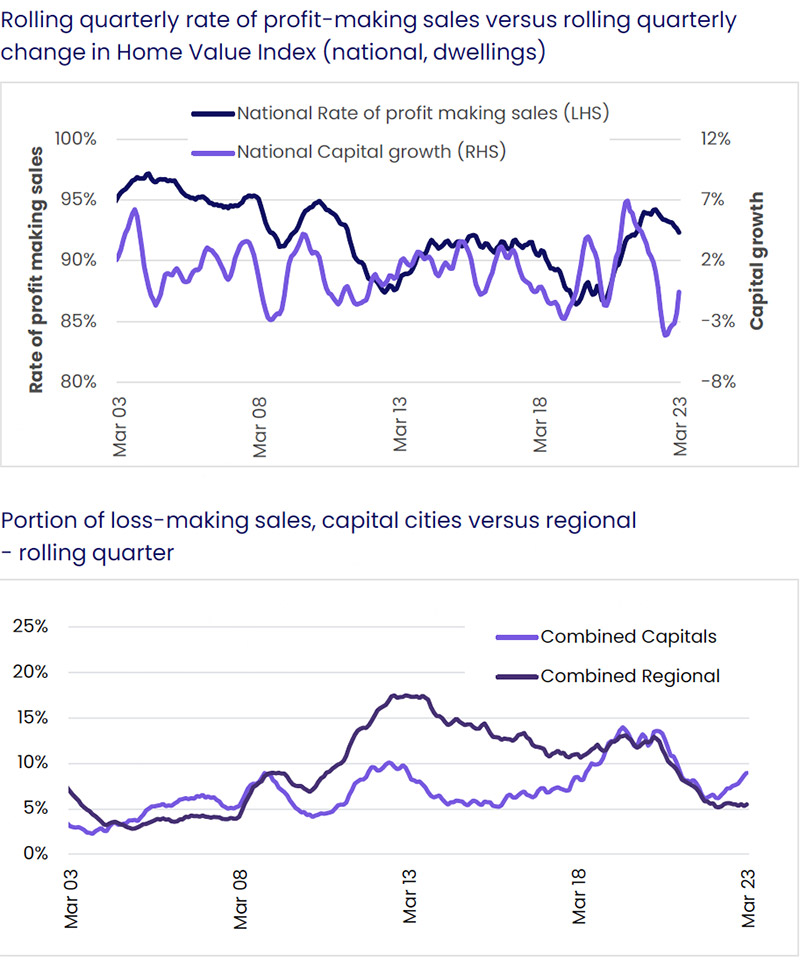Property sales less profitable nationally but has anybody told Victoria?
Inflation is easing just as property sales around the country are becoming less profitable but one state stands out when it comes to attracting buyer interest.
When it comes to the proportion of property sales making a loss Western Australia is hurting more than other states, while buyers seem transfixed on the Victorian property market.
For the third consecutive quarter the rate of profit-making resales around the country has dropped, although this week’s fall in inflation may offer hope of a turnaround down the track.
While there’s no sign in the market yet of panic selling, indications are emerging that some property owners are willingly selling at a loss to avoid rising mortgage interest repayments.
According to CoreLogic’s Pain and Gain Report June 2023, the rate of lossmaking sales was most concerning in the unit market, while Darwin and Perth had the most disgruntled sellers accepting a loss on their property investment.
The rate of loss-making sales nationally across the house market increased by 20 basis points to 3.8 per cent in the March quarter, but the share of loss-making unit resales jumped to 15.4 per cent from 13.8 per cent in the previous quarter.

Source: Corelogic.
Of the capital city markets, the rate of profit-making sales was highest in Hobart, where 99.0 per cent of resales made a nominal gain. This was followed by a rate of 98.1 per cent across Canberra and Adelaide.
At the other end of the spectrum, Darwin, Perth, Sydney and Melbourne saw increases in the rate of loss-making sales to relatively high levels.
In Sydney, the incidence of loss-making sales reached 10.7 per cent in the March quarter, its highest level since the three months to August 2009. The Brisbane housing market saw a slight increase in the rate of profit-making sales, to 95.7 per cent in the quarter.
Property buyers keen on Victoria
Around one in ten Melbourne sellers may have sold at a loss but that hasn’t tempered the flood of enquiries and buyer interest in the Victorian capital and some of its scenic regional areas.
Winter is typically a quieter season for the property market but clearance rates in June were higher than the lows seen late last year, and auction volumes are staying in line with last year’s levels.
New data from PropTrack has revealed the most in demand suburbs this winter, based on the most highly engaged people for houses listed on realestate.com.au in the past year.
Houses |
|||
| Suburb | State | Postcode | Highly engaged buyers in the suburb |
|---|---|---|---|
| Berwick | VIC | 3806 | 41,860 |
| Buderim | QLD | 4556 | 38,452 |
| Kew | VIC | 3101 | 33,229 |
| Point Cook | VIC | 3030 | 32,671 |
| Brighton | VIC | 3186 | 32,262 |
| Croydon | VIC | 3136 | 32,230 |
| Richmond | VIC | 3121 | 31,833 |
| Mount Martha | VIC | 3934 | 31,268 |
| Frankston | VIC | 3199 | 31,265 |
| Werribee | VIC | 3030 | 30,908 |
Units |
|||
| Melbourne | VIC | 3000 | 74,890 |
| Surfers Paradise | QLD | 4217 | 51,659 |
| South Yarra | VIC | 3141 | 44,863 |
| St Kilda | VIC | 3182 | 39,082 |
| Richmond | VIC | 3121 | 36,139 |
| Southbank | VIC | 3006 | 33,360 |
| Hawthorn | VIC | 3122 | 33,038 |
| Brisbane City | QLD | 4000 | 32,812 |
| Southport | QLD | 4215 | 29,702 |
| Adelaide | SA | 5000 | 28,554 |
Anne Flaherty, Economist, PropTrack, said Victoria is seeing the highest level of engagement of any state, particularly among those looking to purchase a house.
“Victoria accounted for nine of the top 10 most highly engaged suburbs for houses and six of the top 10 for units.
“Suburbs seeing the most engagement among those looking to buy a house are typically located in middle and outer metropolitan areas of capital cities.
When it comes to the suburbs seeing the highest level of engagement for units, inner city areas dominate, with the Melbourne, Brisbane, and Adelaide central business districts all making the national top 10.”

Source: Corelogic.
“Across all states, the suburbs seeing the most engagement from buyers are typically located in scenic areas that combine high levels of liveability with excellent amenity.
“Standout regions include Sydney’s scenic Northwest, Melbourne’s Outer East and Mornington Peninsula, and Queensland's Gold Coast,” Ms Flaherty said.
Julie Kelley, Global Sales and Marketing Manager for aussieproperty.com, said the country is experiencing an influx of new residents and an increase in new buyers who are transitioning from renting – buoyed by the fact that in some cases purchasing a home is more affordable than renting.
“While we welcome 1,361 people day to Australia our housing market is unable to cope.
“According to Domain, Australia will require an additional 487,984 homes in the next four years to house 1,235,000 net oversees migrants, equating to 341 new homes every day for four years.
“This is a political nightmare given dwelling approvals are down and investment into new dwellings is declining.
“Given this, I believe it’s realistic to predict the Australian housing crisis will worsen, driving housing and rental prices up with increased demand,” Ms Kelley said.
Will falling inflation quell interest, hit sales profitability?
Inflation may at last be responding to more than a year of interest rate hikes, with Australia’s Monthly Consumer Price Index (CPI) Indicator dropping to an annual rate of 5.6 per cent for May, down from 6.8 per cent recorded in the previous month.
This significant figure, released by the Australian Bureau of Statistics on Wednesday (28 June), represents the smallest annual increase since April 2022 and came in well below market expectations of 6.1 per cent.
If the Reserve Bank of Australia (RBA) sees this as a plausible reason to hit pause on interest rates, the proportion of sales expected to be made at a loss over the coming year could decline appreciably as distressed sales abate.
Of concern to borrowers and potential buyers will be the hidden detail in that inflation figure.
While the likes of the Real Estate Institute of Australia are saying the RBA should stop rate rises indefinitely in response to this latest ABS data, the RBA may be less convinced.
The lower CPI figure was largely driven by items volatile price changes, like fuel, fruit and vegetables and holiday travel. When these factors are stripped out, the decline in inflation was more modest, landing at 6.4 per cent, a drop of just 0.1 per cent.
Shane Oliver, Head of Investment Strategy and Economics and Chief Economist, AMP Investments, said the risk of recession globally and in Australia has increased with ongoing central bank rate hikes.
“Australian home prices have rebounded from their lows as a severe supply shortfall has dominated rising rates, however, a recession could drive another leg down in home prices as buyers back off, higher rates and higher unemployment push up distressed selling, and recession drives reduced household formation,” he said.
“CoreLogic data shows a 9 per cent fall in capital city property prices in the early 1980s recession with a 25 per cent fall in Sydney, and a 6 per cent fall in the early 1990s recession with a 10 per cent fall in Sydney.”
Time, and the RBA, will tell if this pays out as continued increases in sales made at a loss and a decline in interest in property investment.



















